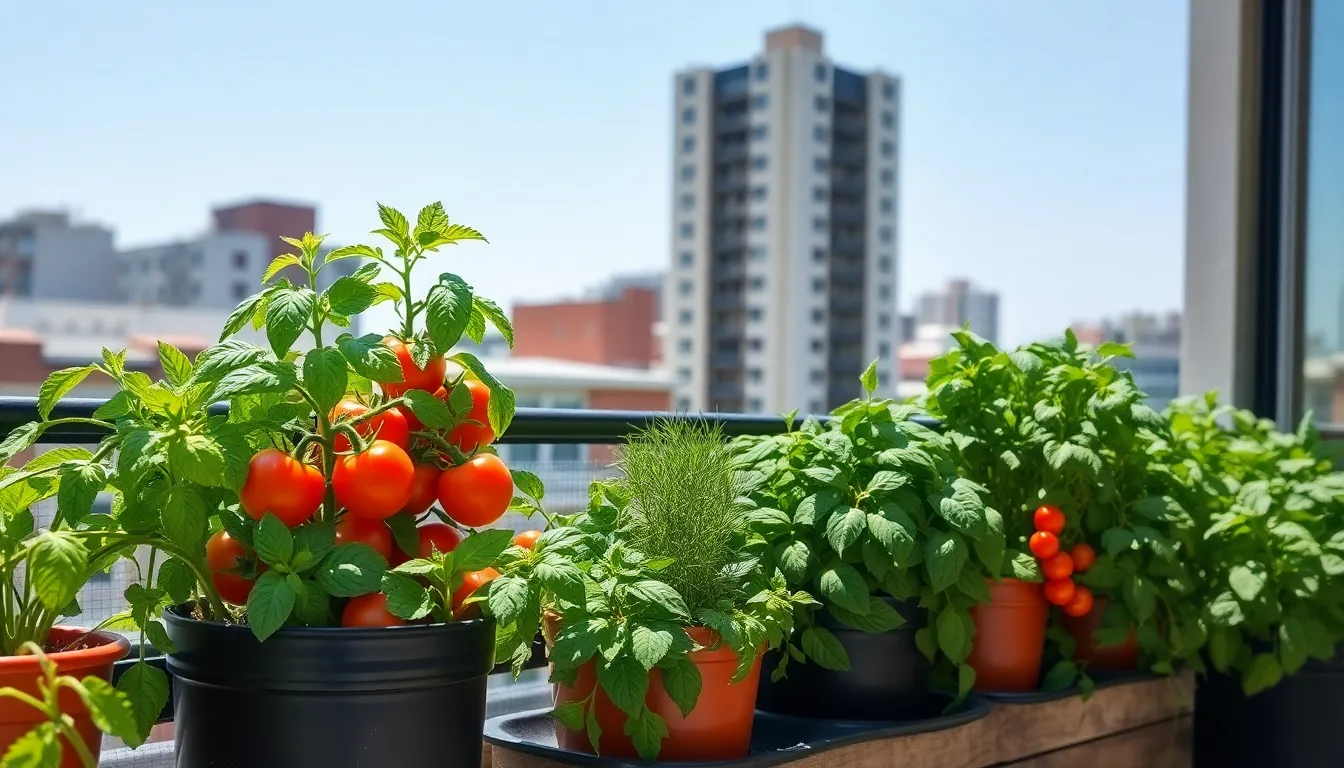Table of Contents
ToggleIn a world where concrete jungles reign supreme, urban gardening is the refreshing breath of fresh air city dwellers crave. Imagine transforming that tiny balcony or rooftop into a lush oasis, where fresh herbs and vibrant veggies flourish right outside your window. It’s not just a hobby; it’s a green revolution that’ll make your neighbors green with envy!
Understanding Urban Gardening
Urban gardening embraces the idea of growing plants in city environments, often utilizing limited spaces such as balconies, rooftops, and community gardens. This movement signifies a shift toward sustainable living and provides numerous opportunities for city dwellers.
What Is Urban Gardening?
Urban gardening involves cultivating plants in urban areas, often in small or unconventional spaces. City residents transform rooftops, balconies, and even windowsills into green sanctuaries. It encompasses growing vegetables, fruits, herbs, and flowers in various forms, including container gardens and vertical gardens.
Benefits of Urban Gardening
Urban gardening provides multiple benefits for city inhabitants. First, it promotes food security by allowing individuals to produce fresh, organic produce at home. Second, this practice enhances mental well-being by connecting people with nature. Third, urban gardens help mitigate environmental issues, such as air pollution, by improving local air quality. Additionally, they foster community engagement, encouraging neighbors to connect and collaborate on gardening projects.
Getting Started with Urban Gardening

Urban gardening begins with understanding your available space. Optimizing even small areas yields great benefits in food production and well-being.
Assessing Your Space
Evaluating the available area is crucial before starting an urban garden. Consider factors like sunlight exposure, access to water, and wind conditions. Taking measurements ensures ample room for plant growth. It’s possible to use balconies, rooftops, or window sills effectively by maximizing vertical space. Observing how much sunlight each section receives throughout the day assists in planning the garden layout. Identifying the microclimates within the space helps in selecting suitable plants.
Choosing the Right Plants
Selecting the right plants significantly enhances urban gardening success. Opt for compact varieties that thrive in limited spaces, such as dwarf tomatoes or salad greens. Incorporating herbs like basil and mint adds flavor and fragrance to any garden. Focusing on plants that respond well to local climate conditions ensures healthy growth. Understanding growth cycles and seasonal adjustments aids in maintaining a steady supply of fresh produce. Choosing perennials reduces annual replanting efforts, making long-term gardening easier.
Essential Urban Gardening Tips
Urban gardening thrives on specific techniques that maximize limited space for successful plant growth. Choosing the right approach makes it easier to cultivate a flourishing garden.
Soil Selection and Preparation
Selecting quality soil serves as the foundation for any urban garden. Gardeners should utilize organic potting mixes that provide drainage and nutrients. Incorporating compost enriches soil, boosting microbial activity and fertility. Testing soil pH benefits plant selection, ensuring healthy growth. Urban gardeners often blend various materials like peat moss and perlite for optimal consistency. Preparing soil before planting improves root development and moisture retention. Tilling soil lightly aids in aeration while preventing compaction.
Watering Techniques
Efficient watering practices significantly impact urban gardening success. Drip irrigation systems deliver consistent moisture directly to plant roots, reducing waste. Gardeners may choose self-watering containers to simplify maintenance. Monitoring soil moisture levels helps prevent under or overwatering. Watering early in the morning or late in the evening reduces evaporation. Utilizing mulch retains soil moisture and minimizes weed growth. Implementing these techniques ensures plants receive adequate hydration without unnecessary effort.
Vertical Gardening Solutions
Vertical gardening provides innovative ways to maximize space in urban environments, allowing city dwellers to grow vibrant gardens even in limited areas. Utilizing vertical space helps transform walls and other structures into lush, green landscapes.
Utilizing Wall Space
Transforming walls into gardens offers numerous benefits. Vertical planters anchored to walls can accommodate various plants like herbs, succulents, and even strawberries. Gardens thrive in this setup, as they receive adequate sunlight and airflow. He or she can also install trellises for climbing vegetables, such as beans and peas. Vertical gardening solutions foster aesthetic appeal and make efficient use of limited horizontal space. They encourage quick access to freshly-harvested produce right at home.
Container Gardening Options
Container gardening supplies versatility for urban farmers. Planters in various shapes and sizes fit easily on balconies, patios, or even windowsills. Starting with pots made of materials like plastic or terracotta enables gardeners to choose lightweight options. Select compact vegetable varieties, such as cherry tomatoes or baby carrots, suited for container growth. Position containers to maximize sunlight exposure while ensuring proper drainage. Incorporating self-watering systems also simplifies maintenance, keeping plants hydrated without constant attention. These options create flourishing urban gardens without occupying too much ground space.
Maintaining Your Urban Garden
Maintaining an urban garden requires consistent care and attention. The following tips cover essential strategies for pest management and seasonal care.
Pest Management Strategies
Effective pest management ensures healthy plants and bountiful harvests. Utilizing companion planting helps deter pests; for instance, basil repels fruit flies, while marigolds ward off nematodes. Monitoring plants regularly allows early detection of pests; she notices any unusual signs of distress. Employing organic solutions, such as neem oil or insecticidal soap, provides a safe yet effective means to control infestations. Encouraging natural predators like ladybugs and lacewings creates a balanced ecosystem. Maintaining proper plant health strengthens resilience against pests.
Seasonal Care Tips
Seasonal care adapts gardening strategies to changing weather conditions. During spring, planting herbs and vegetables suited for cooler temperatures fosters early growth. As summer approaches, timely watering becomes crucial; deep watering encourages strong root systems. Autumn presents opportunities for harvesting and preparing the garden for winter. Removing dead plants and adding compost improves soil health for the next season. In winter, protecting plants from frost with row covers or blankets helps retain warmth. Regularly checking indoor plants for light and moisture ensures thriving growth year-round.
Urban gardening opens up a world of possibilities for city dwellers seeking to reconnect with nature and enhance their living spaces. By transforming limited areas into green sanctuaries, individuals not only grow their own fresh produce but also contribute to a more sustainable lifestyle.
With the right techniques and a bit of creativity, anyone can cultivate a thriving garden that brings joy and nourishment. Embracing this trend can foster community connections and promote environmental awareness. Whether it’s a balcony herb garden or a rooftop vegetable patch, urban gardening is a rewarding journey that enriches urban life.



